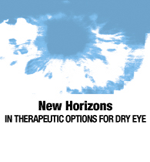Article
New horizons in therapeutic options for dry eye
Patients with symptoms of dry eye make up about 30% of patients in the general ophthalmology practice, yet until lately management of this common condition was difficult due to the complex, multifactorial nature of the disease and the subjective nature of patients' complaints. However, recent breakthroughs in understanding of dry eye are leading to improved diagnostic and treatment approaches.

Patients with symptoms of dry eye make up about 30% of patients in the general ophthalmology practice, yet until lately management of this common condition was difficult due to the complex, multifactorial nature of the disease and the subjective nature of patients' complaints. However, recent breakthroughs in understanding of dry eye are leading to improved diagnostic and treatment approaches.
Michael A. Lemp, MD, clinical professor of ophthalmology at Georgetown University, Washington, DC, outlined the current understanding of the pathogenesis of dry eye in a continuing education symposium at the Venetian Hotel Saturday evening. Dr. Lemp, the program chairman, and a panel of specialists from around the world described the latest options for long-term effective management of this chronic condition.
The primary factors in the pathogenesis of dry eye disease are systemic autoimmune disease, hormonal insufficiency, age-related atrophy and apoptotic breakdown, and iatrogenic causes such as LASIK, drugs, contact lens wear, and computer use, Dr. Lemp said.
Despite its multifactorial nature, the final expression of dry eye is much the same in all patients and encompasses ocular surface damage, visual aberrations, and subjective distress.However, the complex zone of interactions that causes dry eye also means that there are many possible entry points for drug therapy, Dr. Lemp said.
Two broad classifications of dry eye have been identified, aqueous tear deficiency dry eye (ATD) and evaporative dry eye (ETD), according to Allan R. Slomovic, MA, MD, FRCS(C), associate professor of ophthalmology at the University of Toronto. However, there is considerable overlap between the two groups, and 40% of patients with ATD also have ETD.
Dr. Slomovic outlined a simple dry eye diagnostic algorithm that uses techniques commonly employed by comprehensive ophthalmologists. The first step is to obtain a history of dry eye symptoms, including both ocular and medical histories. Next, determine tear break-up time. Values below 10 seconds are suspect, and values below 1 second are abnormal. The third step is to conduct the Schirmer's test, preferably without anesthesia.
In the fourth step, the clinician performs diagnostic eye staining with fluorescein, lissamine green, or rose bengal. Fifth, test for serum antibodies, which is particularly helpful if Sjogren's Syndrome ATD is suspected. The last step is meibomian gland evaluation.
"With this algorithm, you can reliably diagnose a dry eye and determine if it is due to ATD or ETD or both," Dr. Slomovic said. The algorithm results also help the clinician evaluate severity, which in turn drives the choice of treatment.
Among the dry eye treatment options, lubricants are the first choice, said Alejandro Aguilar, MD, director of the ocular surface department, Grupo Medico Las Lomas in Martinez, Argentina, and associate professor of ophthalmology, Universidad del Salvador, Buenos Aires. Lubricants provide a protective epithelial shield, integrate with the tear film, are long lasting and comfortable, facilitate restoration and cellular replacement, maintain ocular surface health, and prevent future damage, Dr. Aguilar said.
In his practice, he recommends Systane (Alcon Laboratories) preservative-free, multi-dose tear replacement formulation.
Tear substitutes alone will not always effectively treat dry eye, said Maurizio Rolando, MD, associate professor in the department of neurosciences, ophthalmology, and genetics at the University of Genoa, Italy.
"You have to treat all of the conditions together to break the vicious cycle," he said. Clinicians need to increase tear volume, improve lubrication, improve mucous conditions, improve corneal epithelium, reduce evaporation, treat the lids, control inflammation, and supplement growth factors.
He also advised clinicians to be dynamic, adjusting patients' therapy to changing conditions, and to teach preventive measures such as increasing humidity in the home and wearing protective glasses.
The program was jointly sponsored by the New York Eye and Ear Infirmary, which received a financial benefit from Alcon Laboratories Inc., and by CME2, an independent subsidiary of Advanstar Communications, publisher of Ophthalmology Times.
Newsletter
Don’t miss out—get Ophthalmology Times updates on the latest clinical advancements and expert interviews, straight to your inbox.




